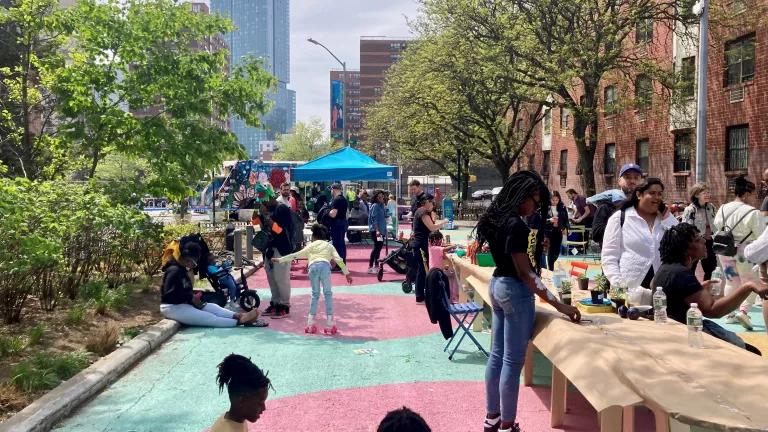Tenant Protections, Good Jobs Key to Decarbonizing Buildings
In Los Angeles, buildings are the top source of carbon pollution, and the city is taking bold steps to end these harmful emissions completely by 2050. As city leaders and other stakeholders consider how to achieve these emissions reductions equitably, two new reports show that tenant protections and family-sustaining jobs must be at the heart of any building decarbonization policy.

This blog was co-authored with Agustín Cabrera, Director of RePower LA, Los Angeles Alliance for a New Economy (LAANE) and Chelsea Kirk, Research and Policy Analyst, Strategic Actions for a Just Economy (SAJE).
It’s no secret that reducing greenhouse gases is an essential step to mitigating the worst effects of climate change. In Los Angeles, buildings are the top source of carbon pollution, and the city is taking bold steps to end these harmful emissions completely by 2050. As city leaders and other stakeholders consider how to achieve these emissions reductions equitably, two new reports show that tenant protections and family-sustaining jobs must be at the heart of any building decarbonization policy.
Building decarbonization includes replacing gas furnaces, boilers, water heaters, stoves, and clothes dryers with highly efficient electric appliances that can run on 100 percent clean electricity—alongside efforts to continue reducing energy waste in buildings. This must be done in a way that prioritizes the most vulnerable communities (including communities of color and those with lower incomes), addresses other housing-related health impacts, supports local economies, and creates family-sustaining jobs.
Ample research has found that Black, Latinx, and low-income communities disproportionately suffer the effects of poor air quality and climate impacts. While reducing emissions from buildings is critical to addressing the climate crisis, failing to center such policies around tenant and worker protections risks exacerbating existing inequalities. Enacting new regulations that keep landlords from passing upfront costs on to renters, many of whom are already on the brink of displacement, could help alleviate some of these challenges. Upgrading buildings creates new jobs, and it is our shared responsibility to ensure that these jobs are high-road and family sustaining, through the adoption of intentional policy.
In order to get this policy right, we need to understand the potential risks and benefits that building decarbonization may generate—and two new reports seek to do just that. One study (full report, summary), from Strategic Actions for a Just Economy (SAJE), examines the potential consequences for renters and how thoughtful policies can help instead of harm. The other, a labor study (full report, summary) from Inclusive Economics in coordination with Los Angeles Alliance for a New Economy (LAANE), takes inventory of LA’s building stock and the costs associated with decarbonization and analyzes the employment impacts of various policy and program scenarios.

Ensuring Benefits for Renters
The majority of Angelenos are renters, and nearly half of those in LA’s most vulnerable neighborhoods spend more than 50 percent of their incomes on rent and utilities. The pandemic has worsened this crisis: many households are unable to pay rent, and over 60 percent of LA residents report job loss or reduced wages. The costs of decarbonization could be significant because it involves replacing major appliances and making other improvements. While these costs should be covered by the building owner rather than the renter, the SAJE report describes how these costs could be passed on to vulnerable renters or used as an excuse to displace tenants. Energy bill savings are also possible but, if the work is poorly done and inefficient appliances are used, cash-strapped renters may even see higher bills and fall further into debt.
In order to prevent such scenarios, SAJE offers a series of recommendations, which include forbidding property owners from passing the costs of decarbonization retrofits on to tenants, prohibiting corporate landlords from receiving public decarbonization assistance, offering decarbonization subsidies to those providing affordable housing, requiring efficient equipment and other efficiency upgrades to ensure lower energy costs, and ensuring that all decarbonization mandates address the health and wellbeing of tenants in addition to carbon reductions. Addressing the health and wellbeing of tenants includes making needed repairs, removing asbestos, remediating mold, and using only non-toxic products as part of the upgrades.

Improving Employment Opportunities
Beyond making Angelenos’ living environments healthier and reducing climate impacts, decarbonizing buildings also holds the potential to create thousands of well-paid jobs. The Inclusive Economics report estimates that an ambitious efficiency and electrification program in LA could create 18,000 new, full-time jobs over 29 years, and that these new jobs would outnumber jobs lost in the gas sector. The report digs into precisely how much upfront investment is needed to decarbonize existing structures in different sectors like schools, commercial buildings and affordable housing while also offering guidance on designing policies that benefit everyone.
These new jobs created by decarbonization aren’t guaranteed to be high quality, particularly in the private construction market, so we need to adopt robust labor and apprenticeship standards. Public investments should also be directed to sectors that already have higher labor standards or should include targeted hire and capacity building for specific populations. Good-paying union jobs currently associated with gas infrastructure can also be protected by investing in district energy systems, dual piping for water reuse, and heat pump systems in larger buildings that pipefitters are already starting to train to install to the highest standards.
LA has the opportunity to create policies and programs that not only create family-sustaining jobs, but also expand tenant protections and provide direct benefits to residents, reduce energy burden, improve public health, and support housing preservation and stabilization. The good news is that LA is making great strides in reducing emissions: Already, 37% of LADWP’s electricity comes from renewable sources, and its grid will be 97% carbon-free by 2030. Under the LA Green New Deal, the city’s buildings will be completely decarbonized by 2050.
But these figures alone don’t tell the whole story, since decarbonization without benefiting vulnerable Angelenos and workers is not a victory at all. The path to cleaner, more just living conditions for all Angelenos is not without challenges, and it’s crucial that these issues be addressed head on. While these reports lay a solid foundation to inform stakeholder engagement, they represent not the end of the discussion, but the beginning.
Employment Impacts Report
Los Angeles Building Decarbonization: Community Concerns, Employment Impacts, and Opportunities
Full Report | Summary
Tenant Impacts Report
Los Angeles Building Decarbonization: Tenant Impacts and Recommendations
Full Report | Summary




